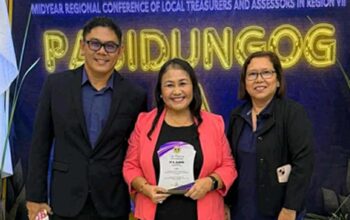
AS far as the authorities in charge of keeping the peace and internal security operations in Bohol, the communist terrorist group (CTG) of the New People’s Army (NPA) who have kept a tight grip on Boholanos and who feasted on the people’s fear, have been dismantled.
This forms the gist of the report which the 47th Infantry Battalion shared to the media during the weekly Capitol Reports featuring Bohol’s peace and order situation.
Speaking for Lieutenant Colonel Allysion Depayso, commanding officer of the 47IB based in Camp Rajah Silatuna in Katipunan Carmen, 47IB Executive Officer Major Jason Torino hared a very intriguing report.
“Based on the periodic reports status which the army and police joint task force, from 18 members of the armed terrorist group in Bohol, there are now only 10,” Major Torino said during in front of the local media.
“They can not conduct anymore offensives against the government,” he continued adding that they have also recently recovered the harbor site of the communist terrorist guerillas.
Saying short of admitting Bohol is insurgency-free like it was in 2010 when the Armed Forces of the Philippines conferred upon Bohol the neat slate status, all the ranking army official can say is that Bohol is “almost insurgency free.”
In reaction to that phrase, Bohol Provincial Commander of the Philippine National Police based in Camp Dagohoy commented that the situation in Bohol, “based on the joint letter directive of the PNP and the AFP states that the communist terrorist group of the Communist Party of the Philippines’ New People’s Army (CPP-NPA) has been dismantled and that this group has not been considered a threat.”
“They are not anymore considered a threat. They now have 10 men and some 11 fire arms,” the top police chief said.
Back in the 1980s until early 2000, Bohol was plagued by rebels who have entrenched themselves in the barangays and fed on the fear of the people to sustain them in their nefarious extortion activities to raise money, but their members hardly had any share in their loot.
Between late 90s to the early 2000s, the local administration put up a poverty reduction program that infiltrated the grassroots, effectively engaging communities in the tri-folding of sectors to combat poverty, which then governor Erico Aumentado pointed to as the cause of insurgency.
With local governments actively engaging communities and with key infrastructure reaching remote areas allowing more access to government and private sector services including expanded wireless communications, armed men who happen to be exposed in vigilant communities easily get reported, making their lives even more difficult that it was.
With a severely reduced force in Bohol, the CTG of the NPAs have to transfer their base of operations to Negros Island, which also forced the government troops to pull out to pursue the fleeing rebels.
What was left was a small company of army engineers and a small force of the army’s combat troops now wielding hammers, saws and shovels, doing civil military operations and aiding the government in recovery efforts.
By February of 2010, the AFP declared Bohol insurgency free, despite the few remaining unarmed remnants of the insurgency doubling up its recovery efforts in the province’s white areas.
Years later, the army reported a few sightings of armed men in the mountain barangays, none of these however resulted in bloody encounters until the last part of the previous administration when a ranking official of the rebel movement was among the casualties in an encounter in Cabacnitan, Bilar. (RAHC/PIA-7/Bohol)



